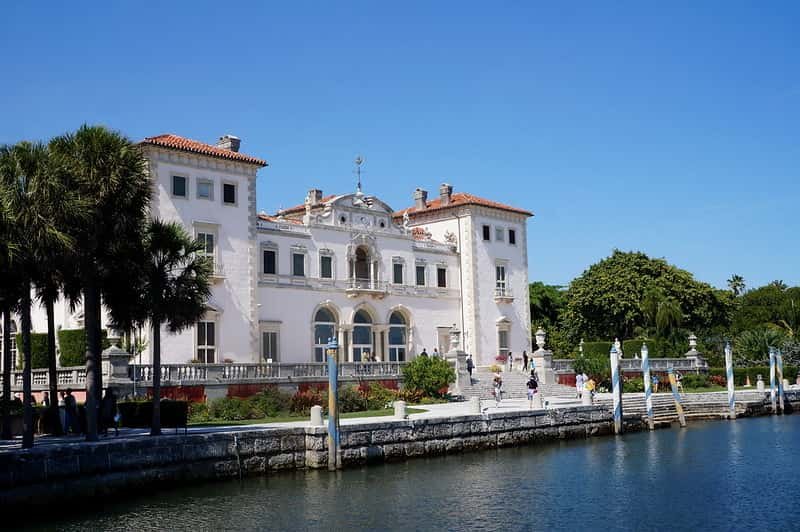Vizcaya House Miami
Visit the incredible Vizcaya House: a big crush on visiting this incredible house (house is a weak word, it’s a real palace), the Venetian style. Take the audioguide, let yourself be guided through the rooms and the gardens.
Entrance fee is US$25 per person, children aged 6-12 US$ 10 (prices are subject to change),, and we recommend taking the audio guide, for US$5 more, as it tells much more detailed stories.
A palace at the waterfront
James Deering chose the name of his house himself: it is a mix between the name of the bay just opposite, Biscayne, and that of Vizcaino, a Spanish explorer.
The Renaissance was a great source of inspiration for creating the house, there are many small Venetian touches, in particular this very particular pier (below, on the right), where the boats “parked” when they came to visit Vizcaya Villa. The gardens are bordered by a mangrove, which has the merit of limiting the damage when there is a hurricane, and giving a somewhat wild aspect to all this well thought-out beauty.
Origin of the Vizcaya House
At the origin of this enormous house/castle/museum, is James Deering, the heir of a wealthy Chicago family, who had made his fortune in agricultural equipment. James was treasurer of his father’s company, but in poor health he sought a suitable retirement, ending up in South Florida (a common excuse at the time – see Barnacle House, also in Coconut Grove, and others). Passionate about art, but knowing nothing about it, he made friends with Paul Chalfin – who had notably been director of the Boston Museum of Fine Arts.
The two men went on a trip together in Europe: Paul advised James to buy such and such a piece of art. James found himself at the head of a gigantic collection. At the same time, he had a huge house built in Coconut Grove, capable of accommodating everything that the two men had dug up in Europe, and which in the meantime was stored in New York.
James spent nine winters in Miami, throwing gigantic parties, showing silent films in his inner courtyard, sailing the bay in a boat, in short, it was the high life of the early 20th century in the United States.
Tropical gardens
It creates a nice setting: the house can be discovered little by little. You can see the whole house, at a glance, when you are in the garden, on the side. I also imagine that the view must be spectacular from the sea.
The French and Italian gardens (but with local plants) have plenty of little hiding places, fountains, statues, fake coral caves, a maze…

Multi-style architectural
The average tourist passing through Miami can now visit this huge house and its incredible gardens. The house is still furnished as it was, except for a few tapestries that have been replaced – having not withstood the heat and humidity over all these decades. Each room has a different atmosphere – Renaissance, Rococo, monastic, Greek, etc., which is not necessarily connected with each other, but the whole in each room and in the house in general is surprisingly harmonious (that reminded me of the beautiful mansions in Newport, which are a bit older). Either way, there are plenty of stories to tell. For example, in the living room, there are in particular
- a fireplace brought back from France – and which dates from the 16th century, on which a tropical motif has been added,
- an organ: an organist lived permanently at the villa during the season,
- a Spanish carpet with Arabic inscriptions, which dates from 1450 (old),
- Imagine that it was in this slightly crazy living room that John Paul II and President Reagan met in 1987. You can really listened to all parts of the audioguide to find out this little story.
Photo credit (main photo): Leandro Neumann Ciuffo / Flickr



